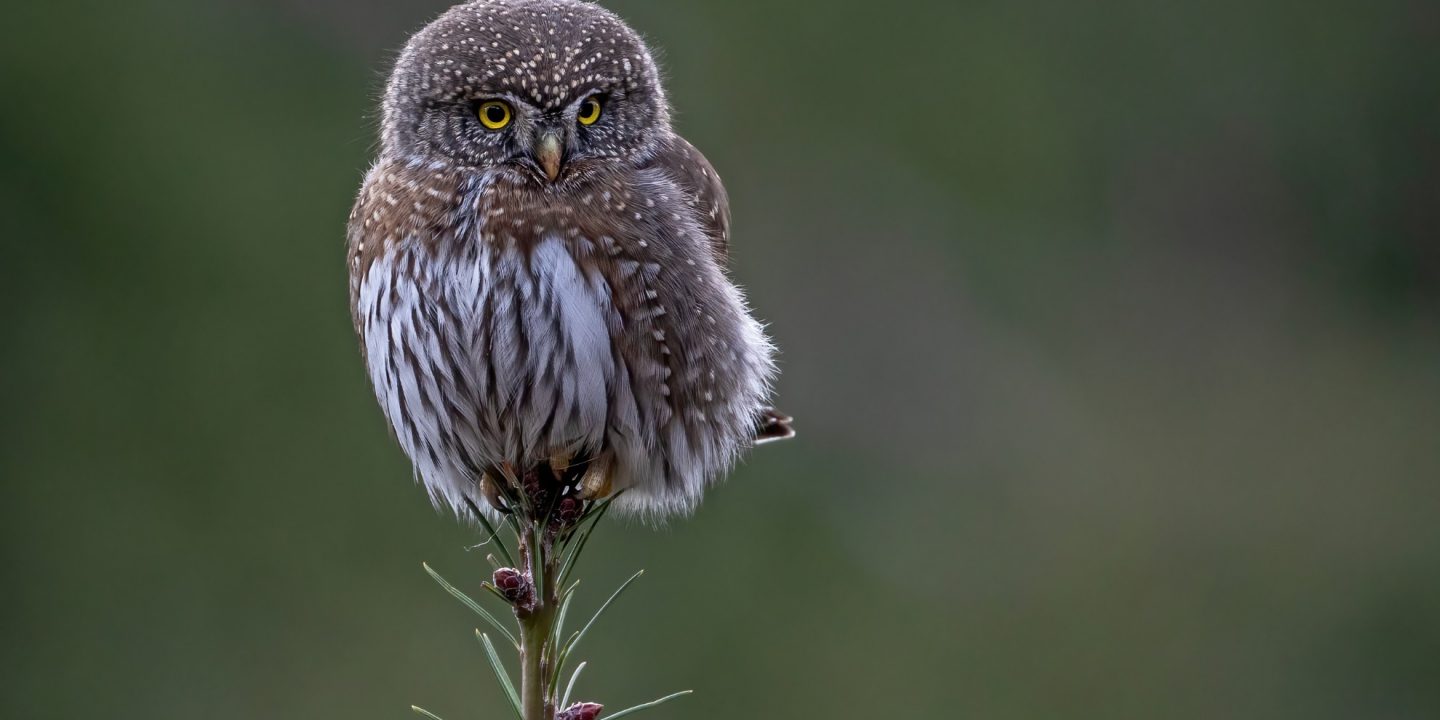Thanks to the Alberta Wilderness Association for this month’s blog.
Boo! I’m a northern pygmy-owl.
Did I scare you? No? Ok, fine. I can understand why. I’ve seen my photos. I look like a wide-eyed, diminutive ball of floof and barely weigh more than a tennis ball. “So cuuuuuute,” people always intone.

The northern pygmy-owl is a year-round forest resident of British Columbia and southwestern Alberta ( Photo: Wilma McKenzie)
But don’t be fooled by my looks; it’s all a ruse. I am FIERCE. A carnivore with a preference for winged prey, I’ve been known to take down birds as big as northern flickers and even chickens! And I’m watching you. Or at least that’s what I want you to think. Thanks to special markings on my feathers, it appears as though I have eyes in the back of my head. And, yes we all tell our children we have eyes in the back of our heads so they’ll behave, but this is so much more! If a predator manages to sneak up behind me, they will think I can see them, which can deter an attack. Smart, right? It might also keep a bit more distance between me and the mob of birds trying to chase me off my perch. With my eyespots, my big brilliant yellow eyes and white and brown streaked chest, I am definitely a looker and a highlight for any birder!
Often the best way to find me is to follow the racket. I’m just trying to have a nap (I swear!) but other birds are concerned I might eat them or their friends and will gang up to mob me on my perch. I guess they DO have reason to be concerned, since my favourite meal is songbirds and I hunt by sitting quietly and surprising birds who unwittingly land nearby. But can’t I just nap in peace? Though my favourite snacks have feathers, I’m not picky and will also eat small mammals and bugs.
Populations of Canada’s most endangered species have declined by more than 50 percent 
If you need more proof of how fierce I am, if I’m feeling full I might just impale my leftovers on some thorns for later. What’s that? Shrikes also do that? Well, I suppose we are both pretty ferocious little beasts! I am diurnal, which means I hunt during the day, but I’m most active at dawn and dusk.

At 16–18 cm tall, the northern pygmy owl is one of the smallest of North America’s owls (Photo: Robbie Keene)
Though we are usually secretive, especially during the nesting season, occasionally we stray into neighbourhoods to hunt, especially during the winter. It always makes me feel like a celebrity, so many people get excited to see me or take my photo. Unfortunately, sometimes people don’t respect my space and interrupt my hunting, or otherwise disturb me. Remember, when you are watching any wildlife species, use respect. Keep your distance, don’t post the exact location of a nest or rare species on social media, and avoid stressing us out.
We pygmy owls occupy a wide range of forest types throughout BC and western Alberta. Though we aren’t well studied, studies that have been done suggest that we prefer older, more complex forests. We nest in tree cavities, but aren’t great at DIY so will either find a hole in a rotting tree or take over a nest made by woodpecker. The boys will pick a nest site and attempt to attract the gals with a short, tooting call. Our apparent preference for mature forests, and need for nesting cavities, means it is extra important to preserve these forest landscapes. The work done by organizations like Alberta Wilderness Association to conserve and protect these wild places is important for owls like us, as well as for the songbirds we rely on for dinner!
The Alberta Wilderness Association has been a voice for Alberta’s wilderness, wild waters and wildlife for 60 years. Defending Wild Alberta through awareness and action, we work to connect the public to Alberta’s wild spaces and inspire people to care.
Want to help Canadian species like the northern pygmy-owl and more? Stay tuned with the latest in Canadian nature by subscribing for email updates. You’ll receive regular updates about what we’re doing to protect Canadian nature and how you can help.
